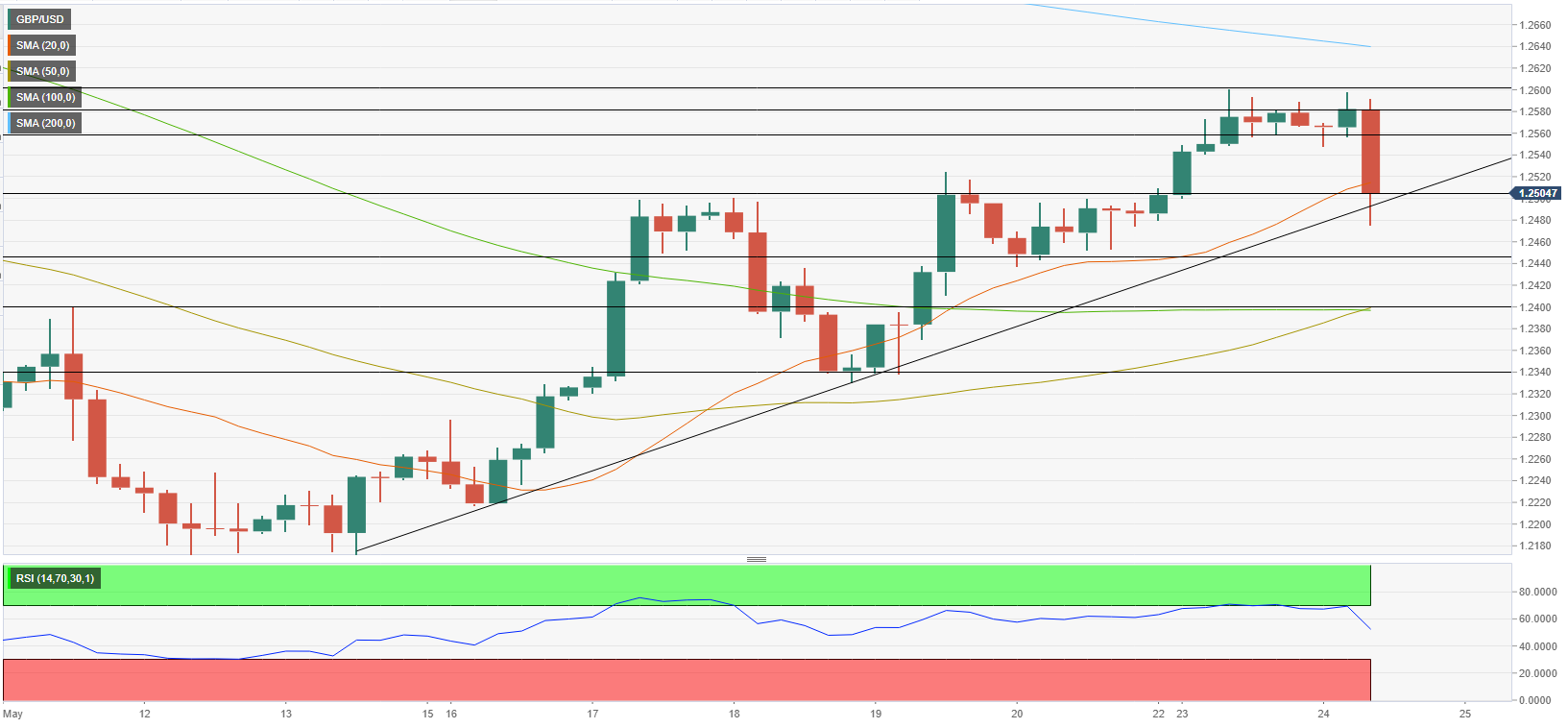- GBP/USD has declined sharply after having tested 1.2600.
- UK PMI data reminded investors of the recession risks in the UK.
- Sellers could retain control if the pair fails to reclaim 1.2500.
GBP/USD has reversed its direction in the European session on Tuesday and dropped below 1.2500, erasing the majority of the gains it registered on Monday. The data from the UK reminded investors of the recession risks in the UK and weighed heavily on the British pound.
The S&P/CIPS Services PMI in May plunged to 51.8 in May's flash estimate from 58.9 in April. This print missed the market expectation of 57.3 by a wide margin. Similarly, the Manufacturing PMI dropped to 54.6 from 55.8 in the same period. Although these figures suggest that the business activity continued to expand at a modest pace in May, the loss of growth momentum is a significant warning sign.
Commenting on the data, "the UK PMI survey data signal a severe slowing in the rate of economic growth in May, with forward-looking indicators hinting that worse is to come," said Chris Williamson, Chief Business Economist at S&P Global Market Intelligence. "Meanwhile, the inflation picture has worsened as the rate of increase of companies' costs hit yet another all-time high."
Bank of England (BoE) Governor Andrew Bailey said on Monday that they are prepared to raise the policy rate again if needed but acknowledged that tightening must take income shock into account. Duncan Brock, Group Director at CIPS, noted that the squeeze on household incomes could further hurt the service sector with consumers reacting to rising energy, food and fuel costs.
Following the dismal PMI surveys, investors are reassessing the BOE's tightening prospects and making it difficult for GBP/USD to hold its ground.
Later in the session, the PMI data from the US will be watched closely by market participants. In case these data highlight the diverging US-UK economic outlook, GBP/USD could extend its slide.
GBP/USD Technical Analysis
The ascending trend line coming from mid-May stays intact despite the latest decline and forms significant support at 1.2500. With a four-hour close below that level, the pair could push lower toward 1.2450 (static level) and 1.2400 (psychological level, 100-period and 50-period SMAs on the four-hour chart).
On the other hand, 1.2530 (20-period SMA) aligns as interim resistance ahead of 1.2560 (static level) and 1.2600 (psychological level, daily high).
Meanwhile, the Relative Strength Index (RSI) indicator is holding near 50. In case the RSI falls below 50 with the pair closing below 1.2500, that could be seen a confirmation of the bearish shift in the near-term outlook.
Information on these pages contains forward-looking statements that involve risks and uncertainties. Markets and instruments profiled on this page are for informational purposes only and should not in any way come across as a recommendation to buy or sell in these assets. You should do your own thorough research before making any investment decisions. FXStreet does not in any way guarantee that this information is free from mistakes, errors, or material misstatements. It also does not guarantee that this information is of a timely nature. Investing in Open Markets involves a great deal of risk, including the loss of all or a portion of your investment, as well as emotional distress. All risks, losses and costs associated with investing, including total loss of principal, are your responsibility. The views and opinions expressed in this article are those of the authors and do not necessarily reflect the official policy or position of FXStreet nor its advertisers. The author will not be held responsible for information that is found at the end of links posted on this page.
If not otherwise explicitly mentioned in the body of the article, at the time of writing, the author has no position in any stock mentioned in this article and no business relationship with any company mentioned. The author has not received compensation for writing this article, other than from FXStreet.
FXStreet and the author do not provide personalized recommendations. The author makes no representations as to the accuracy, completeness, or suitability of this information. FXStreet and the author will not be liable for any errors, omissions or any losses, injuries or damages arising from this information and its display or use. Errors and omissions excepted.
The author and FXStreet are not registered investment advisors and nothing in this article is intended to be investment advice.
Recommended Content
Editors’ Picks
EUR/USD holds below 1.0750 ahead of key US data

EUR/USD trades in a tight range below 1.0750 in the European session on Friday. The US Dollar struggles to gather strength ahead of key PCE Price Index data, the Fed's preferred gauge of inflation, and helps the pair hold its ground.
USD/JPY stays firm above 156.00 after BoJ Governor Ueda's comments

USD/JPY stays firm above 156.00 after surging above this level on the Bank of Japan's decision to leave the policy settings unchanged. BoJ Governor said weak Yen was not impacting prices but added that they will watch FX developments closely.
Gold price oscillates in a range as the focus remains glued to the US PCE Price Index

Gold price struggles to attract any meaningful buyers amid the emergence of fresh USD buying. Bets that the Fed will keep rates higher for longer amid sticky inflation help revive the USD demand.
Bitcoin Weekly Forecast: BTC’s next breakout could propel it to $80,000 Premium

Bitcoin’s recent price consolidation could be nearing its end as technical indicators and on-chain metrics suggest a potential upward breakout. However, this move would not be straightforward and could punish impatient investors.
US core PCE inflation set to signal firm price pressures as markets delay Federal Reserve rate cut bets

The core PCE Price Index, which excludes volatile food and energy prices, is seen as the more influential measure of inflation in terms of Fed positioning. The index is forecast to rise 0.3% on a monthly basis in March, matching February’s increase.
